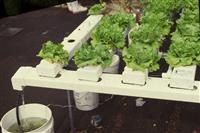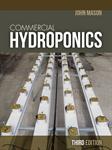Hydroponics For The Home Gardener
 Hydroponics is the technique of growing plants without soil. The roots grow either in air, which is kept very humid; in water, which is well aerated; or in some solid, non-soil medium, which is kept moist. The water around the roots contains a carefully balanced mixture of nutrients that provides food for the plant.
Hydroponics is the technique of growing plants without soil. The roots grow either in air, which is kept very humid; in water, which is well aerated; or in some solid, non-soil medium, which is kept moist. The water around the roots contains a carefully balanced mixture of nutrients that provides food for the plant.
Advantages
The amateur horticulturist can use hydroponic systems at home, even in high rise buildings. A hydroponic system can be clean, light weight, and mechanised. Here are some of the advantages of hydroponic systems.
1. You can grow anywhere
Crops can be grown where no suitable soil exists or where the soil is contaminated with disease.
2. Culture is intensive
A lot can be grown in a small space, over a short period of time. It is also possible to grow in multi-levels.
3. Heavy work is reduced
Labour for tilling the soil, cultivation, fumigation, watering and other traditional practices can be reduced and sometimes eliminated.
4. Water is conserved
A well-designed, properly run hydroponic system uses less water than in-ground gardening. This is an important advantage in areas with poor quality or limited water supplies.
5. Pest and disease problems are reduced
Soil-borne plant diseases are more easily eradicated in many nutriculture systems. This is particularly true in ‘closed systems’ which can be totally flooded with an eradicant. The chance of soil-borne human disease is also reduced.
6. Weed problems are almost eliminated
Weeds are a major problem in most soil-based systems. Weeds are almost non-existent in hydroponic setups.
7. Yields can be maximised
Maximum yields are possible, making the system economically feasible in high density and expensive land areas.
8. Nutrients are conserved
This can lead to a reduction in pollution of land and streams because valuable chemicals needn’t be lost.
9. The environment is more easily controlled
For example, in greenhouse operations the light, temperature, humidity and composition of the atmosphere can be manipulated, while in the root zone the timing and frequency of nutrient feeding and irrigation can be readily controlled.
10. Root zone chemistry is easier to control
Salt toxicities can be leached out; pH can be adjusted; EC (electroconductivity) can be adjusted. Also salts will not bind chemically to the majority of media used in hydroponics so problems of salt build-up that may occur in soils, particularly when highly soluble nutrients are used, are uncommon in hydroponics.
11. New plants are easier to establish
Transplant shock is reduced.
12. Crop rotation/fallowing is not necessary
All areas can be used at all times – you don’t need to leave a paddock for a year to fallow every so often.

John Mason’s book Commercial Hydroponics can be purchased from our online bookshop (Click here). A new edition of this book will be released soon.
More from ACS
Ebook - Over 60,000 copies sold: a classic reference.
View eBook
Course - The opportunities for green walls and roofs will only increase as our cities continue to grow.
This is a solution to environmental and commercial problems on so many levels.
View Course
Course - Discover a wide range of systems, simple and complex, and how to grow many different types of horticulturally valuable crops, such as cut flowers and vegetables.
View Course
Ebook - easy to read: home systems, commercial systems, media, fish species, fish care.
Planting guide and care; trouble shooting - fish and plants.
View eBook